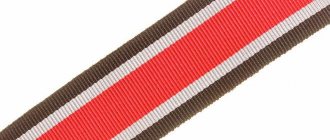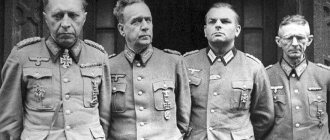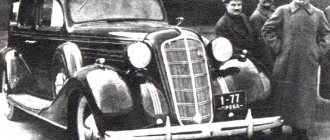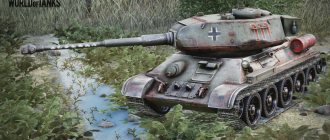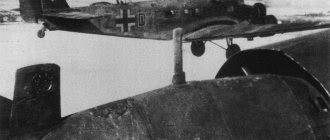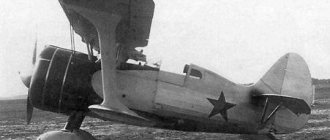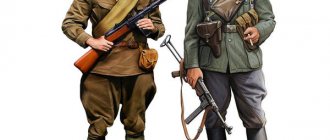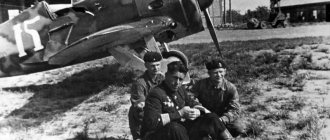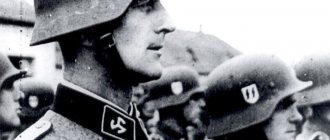Before World War II, the German ground armed forces numbered about three million fighters. In December 1943, they reached their maximum number - 11 million.
In this huge army there was a clear hierarchy of ranks and several types of uniforms. Its main color was “field gray” - “feldgrau”, with a wormwood greenish tint.
Wehrmacht officer and non-commissioned officers in the field
To emphasize the army's devotion to the ideas of National Socialism, the uniform was supplemented with elements of heraldry - emblems and stripes with symbols of the Third Reich. The most noticeable of these is the imperial eagle on the upper chest, which holds a swastika in its claws.
Ranks in the Wehrmacht (hierarchy of ranks of the Reich ground forces)
Just like the Red Army, the Wehrmacht had a hierarchical system of military ranks that became an integral part of Prussian militarism.
Wehrmacht ranks 1939-1945. Rank and file
The hierarchy of lower personnel consisted of 5 ranks.
The most elementary of them - an ordinary soldier - is a shutze (shooter), a gunner (artilleryman) or a pioneer (engineer units).
The next type of rank in the German army is Oberschutze, “senior soldier.” More experienced fighters were marked with the appropriate chevron as a sign of distinction for their experience and well-developed skills.
The next step in the military hierarchy among the rank and file are corporals. They wore additional dark green chevrons - corners pointing downwards. Often the rank of corporal was given to machine gunners. Or those who were trusted with some other weapon, more powerful than ordinary small arms.
Insignia of privates of the German army
Chief Corporal is a corporal who has received an additional badge for his experience, seniority and military merits. There was also the rank of staff corporal, which was abolished at the end of 1942.
These ranks in the Wehrmacht army were awarded to the most experienced soldiers, who for some reason could not be made non-commissioned officers. For example, illiteracy, chronic indiscipline, or suspicions of political unreliability.
Ranks of the German army 1941-1945 among non-commissioned officers
Sergeant and petty officer duties were performed in the Wehrmacht by non-commissioned sergeants, sergeant majors, chief sergeant majors and staff sergeant majors (in increasing order). The type of troops was also added to the holders of these ranks. For example, a sergeant-major-signalman, or a sergeant-major of the medical service.
Shoulder straps of Wehrmacht non-commissioned officers
Non-commissioned officers (except non-commissioned sergeants) could already wear sword belts, making them look like full-fledged officers.
Ranks of German officers and generals
Here everything practically coincides with the hierarchy we are accustomed to in the Soviet or Russian army: lieutenant; chief lieutenant; Hauptmann (captain); major; oberst-lieutenant (lieutenant colonel); oberst (colonel).
Officer's shoulder straps
The general ranks in the Wehrmacht of the 2nd World War were also similar to modern ones: major general, lieutenant general; further – generals of specific military branches. For example, “general of infantry” (infantry); "general of artillery", etc. Even higher are Oberst General, Field Marshal General and Reich Marshal (but there was only one such person - Hermann Goering).
Cartridges and potassium cyanide
On December 24, 1947, border guards in the Soviet zone of occupation of Germany detained a man with dangerous luggage - an elderly man trying to get into the British zone with 19 live cartridges for a 6.35 mm pistol. After his arrest, the German wanted to commit suicide, but border guards discovered potassium cyanide under the lining of his hat in time. It was not the first time that we managed to get the detainee to talk - he turned out to be Wehrmacht General Rudolf Schmidt, commander of the 39th Corps of Army Group Center. Schmidt took part in the capture of Belarus, the Battle of Smolensk and the battles near Leningrad. He was soon taken to Moscow and in 1952 he was sentenced to 25 years in the camps for war crimes. He was one of the few who honestly admitted his atrocities: the abduction of Soviet citizens into slavery in Germany, the organization of punitive operations against partisans, the approval of death sentences...
Schmidt is the last Wehrmacht general arrested by the Soviet Union. The point is not that he skillfully hid, but rather, on the contrary, his own carelessness (otherwise he would have been captured back in 1945 at the front). In 1943, Schmidt was arrested in Orel by the Nazis themselves for letters to his brother, in which he criticized Hitler and other NSDAP leaders for incompetent troop management, and also talked about plans to flee the army. Soon, the general's brother was sentenced to death for spying for the French Resistance (to avoid execution, the brother poisoned himself in prison). Schmidt himself was dismissed from the army, but was still released thanks to the intercession of his colleagues - the case was presented as if his mind was clouded due to a “painful condition.” Schmidt lived in Berlin and Weimar, bought and wrote patents for the production of alcohol, oil and syrup from chestnuts and acorns, and in the Soviet zone in 1947 he came to his friends for personal belongings, among which were those same cartridges.
R. Schmidt. (ritterkreuztraeger.blogspot.com)
Wehrmacht insignia: shoulder straps, colors of military branches
The ranks and types of troops also differed visually. This is a “classic” army tradition in many countries.
German shoulder straps of World War II
The shoulder straps of the German army 1941 1945 for privates and non-commissioned officers were made of simple cloth, but had piping of a certain color (corresponding to the branch of the military). Non-commissioned officers had a braid edging on their shoulder straps.
Starting with the major, the appearance of the shoulder straps changed: they were already made with weaving in the form of a braided ornament. The major's shoulder straps were clean, without stars, the oberst-lieutenant had one silver star in the middle, and the oberst had two.
General's shoulder straps
The generals' shoulder straps were made of gold-colored strands twisted with silver threads in a ribbed pattern.
Wehrmacht, insignia according to the colors of the military branches
Which branch of the military a particular serviceman belonged to could be easily recognized by the corresponding color of the edgings of the shoulder straps, buttonholes, hats and stripes on the uniform. True, they changed and mixed several times. But in the initial period of World War II, a clear distinction by color was still in effect.
General Guderian
French campaign
General Hoth, together with his corps, headed to the western borders to participate in the conquest of France as part of Group A. It was this group of armies that was entrusted with the most important task - to break through the border defenses of Belgium. General Hermann Hoth was behind the Fourth Field Army. This group was commanded by von Kluge. In May 1940, Hoth's unit crushed the Belgian cavalry and Ardennes rangers, reaching the banks of the Meuse River. Having struck, together with Kleist’s unit, the French army in the south of the Somme, he breaks through their defenses. This freed the hands of the rest of the German units. Despite the fact that the French actively resisted, Hoth was already pursuing them at the beginning of June.
The French 10th Army then capitulated. He pursued the rest of the retreating all the way to Brittany. General Hoth divided his group in half, sending the first part to Rommel's tank unit and the second to Brest. After the capture of the Loire and Rouen by the end of June, he was awarded the rank of colonel general.
Beginning of the campaign against the USSR
General Hoth's tank operations also took place across the territory of the Soviet Union. His main goal at the beginning of this campaign was to invade the territory of the state, destroying the enemy forces near Bialystok, and move towards Vitebsk.
He crossed the borders of the USSR on June 22, 1941, hitting the Suwalki salient. He quickly captures the bridges over the Neman River, rushing further to the heart of the country. Thanks to the fact that General Hoth takes enemy troops by surprise, it is possible to defeat the enemy especially quickly. Just a couple of days later, Minsk was captured, where he clashed with Guderian’s corps.
The tank corps met particularly fierce resistance from the Soviet troops, so his army suffered losses when moving towards Vitebsk.
Preface
One of the people who made history – on a global scale! - invites us to familiarize ourselves in this book with his idea of how his actions influenced the events of history and what results this led to, completely unexpected for him. Guderian had a huge impact on the course of the war of his time. Without him, Hitler's belligerent sentiments could have been quickly suppressed at the first attempt to start a war. Indeed, in 1939-1940, the German armed forces were not yet able to defeat the troops of any of the major powers. The triumphant victories that began World War II for Germany were made possible only by the presence of the armored forces that Guderian created and trained, and his courageous command of these troops, despite the caution of higher command and the fears of Hitler. Guderian's breakthrough in Sedan and the lightning rush to the English Channel practically decided the outcome of the war with France.
A year later, his onslaught in the east almost led to the defeat of the Russian armies, but again the indecisiveness of his superiors led to the slowdown of the campaign until the onset of winter, which gave the Russians a respite. Stalin was able to bring in new armies and build new military factories to replace those captured. Russia began to gain strength, but Germany was no longer as strong as in the first campaign. Hitler's second attempt, in 1942, although it posed a danger to Russia, was more limited in scope. After the defeat at Stalingrad, it became clear to the whole world that Germany's power was weakening, and America's entry into the war finally accelerated the outcome of the war.
Thus, Guderian's victories did more harm to his country than if he had been defeated. The early bloom bore bitter fruit.
He himself managed to taste this bitter taste, having been dismissed at the end of 1941 for carrying out a temporary retreat rather than indulging in Hitler’s illusions. He was called back into service only when Germany's situation had already become desperate, and eventually became Chief of the General Staff when it became hopeless. So he drank this bitterness to the dregs.
However, the disastrous consequences of his work do not in any way detract from its historical significance - the creation of history through a new idea, of which he was the exponent and executor. Germany did not retain its conquests, but these conquests redrew the map of Europe and influenced the future of the whole world.
Guderian's book is also of great interest from the point of view of understanding how the specialist's brain works. Guderian's highly developed imagination worked only within the framework of professional topics, and the power of his concentration was greatly increased by his ardent enthusiasm.
Guderian was a professional soldier in the highest sense of the word. He, as befits a master, devoted himself entirely to technical progress. He did not think about career ambitions, nor about the tact required to achieve them, nor about what purposes technical innovations would serve. To understand it means to understand the passion for an idea in its pure form. This is also the explanation for his attitude towards Hitler - more favorable than that of most generals of the old school. Hitler declared his commitment to new military ideas, including the idea of equipping tank troops, so Guderian could not help but like him. Hitler was in conflict with the General Staff and the existing military system, and Guderian, for his own reasons, too, and this initially brought them closer, although as further relations with the Fuhrer developed, Guderian was disillusioned.
It will be clear to readers of his memoirs that he did not question who or what he and his soldiers were serving. For him, it was enough that the country was at war, and therefore was in danger. For him, fulfilling his duty was incompatible with doubts. Like a disciplined soldier, he silently accepted that his country had the right to defend itself against potential adversaries. Readers around the world, aware of the danger Germany posed to their countries, may, of course, be irritated by this position. But Guderian's attitudes correspond to those of any soldier of any country at any time. In the memoirs of British and American commanders of the 19th century, there is also rarely a shadow of doubt about the participation of their countries in wars over rather controversial issues. Guderian's train of thought and way of expressing it have a rather “Victorian” flavor.
Moreover, soldiers throughout the world are accustomed to accept on faith that “attack is the best defense,” so that the difference between attack and defense is considered to be a tactical difference between two alternative actions, and the question of aggression does not arise in this case. Major experts in the field of international law find it difficult to give an unmistakable definition of aggression, and aggressive statesmen always skillfully shift the blame onto the shoulders of their foreign opponents. The clearest cases can always be obscured by appeals to patriotism, and the greater the sense of duty to their homeland in people, the easier it is to deceive them into silence. Soldiers are not trained to investigate who is right in international disputes, and if they allow themselves to get bogged down in this question, they will find themselves unable to do their duty. There is a place for a military philosopher in developing war strategy, but an overly thoughtful mind is not suitable for military service itself.
For reasons of practical necessity, the commander on the battlefield must act without thinking, and, even if he has time to do so, he must not every time calculate the long-term consequences of carrying out the order received, otherwise his actions will be paralyzed. This rule does not apply only to the most senior military leaders (Wellington is an example of this). So while the battle continues, in order to carry out its mission, the military must limit the scope of its thinking to thinking about how to more effectively carry out the order. “Their business is not to think, but to act and die!” No country with its own army can afford to neglect this rule. Where soldiers begin to wonder whether they are fighting for a just cause, armies suffer a crushing defeat.
It is easy to consider Guderian a stubborn militarist, but it is better to recognize that his basic views are the necessary attitudes of a military man. The fact that he does not renounce them when writing his memoirs in order to gain the approval of the judges speaks only of his unshakable honesty, which so often brought him into conflict with his superior commanders and with Hitler, and even, perhaps, of the militant character that made him such an outstanding military reformer and commander.
One should not refuse to read Guderian's memoirs because of a rejection of his style - this is as unreasonable as if his superior commanders ignored his military proposals because of a dislike for him personally. This book is the most complete factual account of the war from the German side that has ever been published. The detailed picture that makes the book a valuable resource is well complemented by vigorous and accurate commentary.
The revelations of the first chapters of the book, which indicate the resistance that Guderian experienced when introducing the idea of developing armored vehicles and ensuring the blitzkrieg methodology, may surprise many readers who imagine the German General Staff as a single visionary organism, consisting of thinkers who only think how to they better prepare for a new war. (What he says will not be such a revelation to those who know what the army is and how conservative it is by nature.)
His story about the 1940 campaign not only reveals all the problems of crossing the Meuse at Sedan, but also describes the entire race of the subsequent push to the English Channel coast. It is as if you are sitting in Guderian's car during this non-stop movement and see how he controls his panzer divisions. For me it was like a dream with a continuation, because before the war I had imagined a properly organized tank attack, but then they assured me that I was a dreamer. When Hobart demonstrated the capabilities of such a throw during an exercise in 1934, the old school soldiers said that this would not work in a real war.
Guderian's account of the attack on Russia in 1941 gives us the most detailed picture of that invasion that is currently available. If the details seem to slow down the pace of the story, I must say that it is greatly enlivened by stories of conflicts in the German command, and his descriptions of the terrible final stage - the winter rush on Moscow through mud and snow - are extremely picturesque. Then follows the story of his dismissal and re-call to duty in 1943 in order to reorganize the tank forces after the defeat at Stalingrad. In the final chapters, he brings new light to the failure of plans to repulse the Allied landings in Normandy.
When the situation became desperate, Guderian was ordered to assume the post of Chief of the General Staff, a position whose powers were at that moment limited by the Eastern Front and even more limited by Hitler's desire to control everything himself. This framework did not leave Guderian much freedom of action, but the new assignment provided him with an excellent opportunity to directly observe Hitler's thinking and emotions in the final stages of the war. It is hardly possible to imagine a more depressing picture of the degradation of an ailing dictator and his demoralized entourage. Guderian concludes his memoirs with sketches and descriptions of the characteristic personality traits of Hitler and other arbiters of the destinies of the Third Reich - and this chapter seems to me the most interesting.
The sharpness and objectivity of these descriptions is extremely remarkable. This chapter slightly reveals one of the qualities of Guderian himself, which does not appear directly in the book, but amazes everyone who interacted with him personally - his sense of humor. Humor is all the more pleasant to note in this case because for people of his circle this is not a typical phenomenon.
However, Guderian failed to correct the situation, which he himself had previously contributed to while in lower positions. When it comes to men of action, their place in history is determined by how much they changed history. Guderian's achievements - his influence on the course of the Second World War and on the way wars were waged in general - speak of him as a military leader of the highest class. He applied the idea of independent use of armored forces, which he developed, so innovatively and decisively that it brought him victories incomparable to anything in the annals of military history.
It is clear that he fully possessed the qualities that distinguish the “great captains” of history - keen observation, confident intuition, speed of thought and action that did not leave the enemy a chance to recover, the gift of tactical and strategic thinking, the ability to win the hearts of his soldiers and achieve carry out the tasks he has planned. It is not clear to what extent he possessed a classical sense of realism. However, he knew how to make the unreal real.
In addition to these qualities, Guderian also had a creative imagination - the main feature of genius, both in the military sphere and in all others. Most recognized masters of military affairs used, as a rule, traditional means and methods. Only a few developed anything new. Inventions in the field of weapons came, as a rule, from outside, usually from one of the civilians. Inventions in the field of tactics belonged, as a rule, to one of the military thinkers and gradually spread through the progressive-minded officers of the new generation. Rarely have any inventors been able to implement the theories they developed themselves. Guderian, however, had the opportunity. And he took advantage of this opportunity with revolutionary results.
Captain B.H. Liddell Hart
Capture of Smolensk
Soon, Hoth's tank units became part of the 4th Panzer Army. The commander of this group of troops was Gunther von Kluge. After a call to the leadership, Hoth was given a combat mission: breaking through the defense of Smolensk. This would ensure freedom of movement for the entire fourth army to Nevel.
Having taken Vitebsk together with the fourth tank division, General Hoth bypassed Smolensk in a northerly direction. But in July, in the Velikiye Luki region, the Red Army prepared a counterattack against tanks. Then the German military leaders ordered to go around the Velikiye Luki area, passing from the west and taking Toropets. There the Soviet troops were broken. By July 15, Smolensk was captured. In the area of Yelnya and Dorogobuzh, German units united even though the Soviet troops stubbornly resisted this. Thanks to the successful unification, Smolensk was completely surrounded.
After this victory, the Knight's Cross of Gotha was supplemented with oak leaves. During attempts to take the city, he commanded infantry troops holding back the enemy who was trying to break through the encirclement. Then Goth was able to find time to recruit his army and allow him to rest.
Consequences
By July 15, the weakened Hoth finished his offensive, withdrawing his units to their original position. Then the Red Army launched Operation Commander Rumyantsev, during which the Germans were driven out. Having wedged themselves into Hermann's troops, they opened the way for their troops to Kharkov, for which German forces entered the battle. However, they lost and were forced to leave the city.
Nevertheless, General Hoth continued to receive awards. He was presented with swords for the Knight's Cross. The tank units were ordered to retreat to the Dnieper. Near Kyiv, Hoth took up defensive positions. The Red Army began to attack the city in October. The remnants of the once powerful army fought off the troops of the Ukrainian Front, but could not do anything. The city was handed over to the Soviet command.
Period after Moscow
Goth is a Wehrmacht general who did not actually participate in the battles for Moscow. He occupied a position at Vyazma and Kalinin. He and his group became part of the “South” formation. He launched an attack on Voroshilovgrad together with the first tank division of von Kleist.
In January 1942, Hoth's troops were attacked by soldiers of the 37th Army of the Red Army. This led to the German retreat to the Northern Donets. However, the tanks of General von Mackensen came to his aid, thanks to which the attackers were stopped. As a result of this struggle, a ledge convenient for Soviet troops appeared on the front of the “South” formation. They could begin to attack at any time with the goal of liberating Kharkov and Kyiv. All German forces were thrown into repelling the counterattack of the Red Army, the ledge was eliminated, and the “South” formation itself was divided in half.
